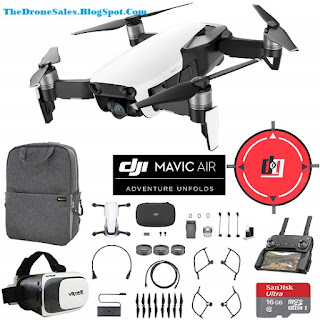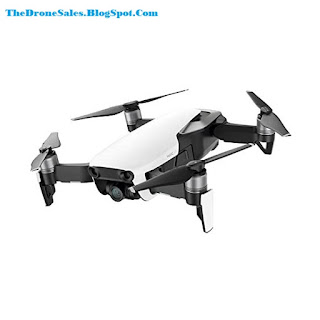DJI's Mavic
Pro caused a ripple effect for its compactness.Drone Combo DJI Mavic Air was the main automaton to have arms that collapsed
against its body, making it very smaller. Since it propelled, numerous others
have handled knockoffs with a comparable plan, yet it would seem that no one
but DJI can thump the Mavic Pro off its roost as our preferred camera ramble.
What's more, it has, with the Mavic Air.
Littler (and
$200 not exactly) the Pro, the $799 Air likewise has collapsing arms and a
similar 4K camera and gimbal as the Pro. Be that as it may, the most recent
model likewise accompanies another item shirking mode that makes it significantly
simpler to direct in limited spaces. It's the reason we thing the Mavic Air is
the best Drone yet.
The Mavic
Air has a smooth look with swooping bends that make it appear as though it's
flying, in any event, when it's on the ground.
 |
DJI Mavic
Air floats over that
ideal center ground, offering very good quality specs at a lower value point
than the Mavic Pro. It has pretty much every ringer and whistle (however this
automaton unquestionably hums) you could request, from 4K video and 32MP all-encompassing
pictures to a 21-minute battery life.
All the more
significantly, the DJI Mavic Air is anything but difficult to fly gratitude to
an improved article evasion framework and motion controls, giving this
automaton more standard intrigue.
The Mavic
Air floats over that ideal center ground, offering very good quality specs at a
lower value point than the Mavic Pro. It has pretty much every ringer and
whistle (however this automaton surely hums) you could request, from 4K video
and 32MP all-encompassing pictures to a 21-minute battery life.
Cost and
accessibility of Combo Drone:
·
Available
at this point
· $799 (£769, AU$1,299) for the automaton and adornments
· $999 (£949, AU$1,599) for the Fly More Combo
· Comparison: Mavic Pro is $999 (£1,099, AU$1,599); Spark is $399 (£449, AU$649)
· $799 (£769, AU$1,299) for the automaton and adornments
· $999 (£949, AU$1,599) for the Fly More Combo
· Comparison: Mavic Pro is $999 (£1,099, AU$1,599); Spark is $399 (£449, AU$649)
With a
beginning cost of $799/£769/AU$1,299, the Mavic Air is less expensive
than its greater altogether ways Pro kin. Following through on this cost gets
you the automaton, a battery, the exclusive charger, overhauled remote
controller, a little conveying case, four propeller gatekeepers and two full
arrangements of propellers.
Given most
automatons' restricted flight time, you should consider putting resources into
different batteries in the event that you need to appreciate the full
understanding of flying one. To get that out of the container with the Mavic
Air, DJI's presenting the Fly more combo evaluated at
$999/£949/AU$1,599. It packages the automaton, three batteries, a remote
controller, a movement sack, two sets of propeller watches, six sets of
propellers, a battery-to-control bank connector and battery charging center
point.
Despite the
fact that the beginning cost is a high speculation for a contraption with a
21-minute battery life, the updated tech housed inside the smooth suspension
makes the Mavic Air very alluring, particularly since it's less expensive than
its greater sibling. Also, in contrast to the Spark, it ships with its own
committed controller, which goes far to supporting the expense.
The Mavic
Air is accessible by means of DJI's online customer facing facade and at
significant retailers.
Structure
and manufacture of Air Drone:
·
Compact
and foldable structure factor returns
·
Recessed
gimbal includes security, yet the clasp on spread is unbalanced
·
Removable
joysticks on the updated controller
·
USB-C
port for information move as it were
The MavicCombo Air may look like the Spark as far as size, yet that is fundamentally
where the similitude closes. The new automaton's arms are foldable, similar to
those of the Mavic Pro, taking convey ability to an unheard-of level.
When
collapsed up, the Mavic Air can without much of a stretch slip into a huge
pocket – think load pants or a major coat. Tipping the scales at 430g, it's
heavier than the 300g Spark yet lighter than the 743g Mavic Pro, and certainly
lighter than 16 ounces of brew.
The
automaton's speed up case fortifies how little it truly is – it effectively
slips into a rucksack or a camera sack with a lot of space to save for the
remainder of the gear.
In spite of
resembling a toy, the Mavic Air is hearty and all around manufactured. The
recessed gimbal, with its clasp on camera spread, includes a layer of
insurance, making this an incredible travel buddy. Be that as it may, popping
the spread back on after use can be a smidgen fiddly, with no ideal method to
cut it back on. You'll simply need to guarantee the camera is confronting
straight ahead or you won't get the spread adjusted appropriately to slide into
position.
Removing a
page from Spark's structure, DJI has propelled the Mavic Air in three hues:
white, dark and red. In spite of the fact that the hues are a fun-loving touch,
we found that the red and dark variants were unique mark magnets. The white
variant looks the best, yet it can turn out to be all the more effectively lost
a way off against a splendid sky.
The Mavic
Air is the first DJI Drone to present USB-C for content exchange.
Tragically, the USB port can't be utilized to charge the automaton. For that,
you'll have to drag around the exclusive charger.
Obviously,
it additionally accompanies a microSD card opening, however this time there's
8GB of locally available capacity also. In this way, on the off chance that
you neglect to convey a card or figure out how to top it off genuine brisk, you
can keep shooting with only a solitary tap.
Another
noteworthy yet basic development that adds to the new automaton's
transportability is the upgraded remote controller. Out of the container, the
joysticks for the controller are concealed flawlessly under the foldable cell
phone cuts, giving the new controller a level surface that permits it to slide
into the pocket at the rear of the automaton's case. Simply evacuate and screw
them on, at that point unscrew and stow away however you see fit.
The
controller comes up short on the Mavic Pro remote's worked in screen for flight
telemetry, yet crush your cell phone into the foldable clasps and, viola, you
approach a live video feed and each other bit of directing data that you need.
Execution
and control of DJI Air Drone:
·
Improved
impediment shirking framework
·
Gesture
controls
·
Top
speed of 68.4 km/h (40 mph)
·
Maximum
transmission separation of 4 km (2.5 miles) with controller; 50m with cell
phone
Setting up
the Mavic Air isn't hard in the event that you've utilized a DJI
ramble previously. On the off chance that you haven't, you'll have to introduce
the DJI Go 4 application on your telephone (accessible for Android or iOS) and
afterward follow the means on screen to associate with the automaton, either
straightforwardly through Wi-Fi or by connecting to the controller. When set
up, flying the automaton is smooth as spread.
Also, it's
quick, or possibly feels that route in view of its modest size. In Sport mode,
this pocket rocket can arrive at a most extreme speed of 68.4 km/h, or 40 mph.
At such speeds, be that as it may, if the camera is confronting sideways,
you'll catch the front propellers buzzing, which may not really be what you
need in your video. All things considered; this is definitely not an issue
except if you're pushing the automaton to its top speed.
Everybody,
notwithstanding, will encounter the way that the Air is noisy contrasted with
the substantially more costly Mavic Pro Platinum with low-commotion propellers.
You'll really hear it before you see it when it's only a little automaton body
in the removed sky.
Tenderfoots
don't have to stress a lot over the automaton dashing around, either – the Mavic
Air is more diligently to crash on account of its seven-camera vision framework
and three-heading natural detecting.
DJI's spic
and span Advance Pilot Assistance System (APAS) doesn't simply leave the
automaton speechless when it comes against a hindrance – it'll outline a backup
course of action and keep flying securely. Nonetheless, for the APAS framework
to work adequately, the automaton needs to fly around and overview the area for
a piece, getting data to process from its environment. That is the main prep
work included, yet it's consequently done by the automaton.
During
testing, we flew our automaton towards stone sections in a surrendered quarry
and the Mavic Air easily flew over a few and around others without us easing up
on the controls.
That doesn't
mean the specialty is totally crash-verification. There are no sensors on the
top and sides, so there could even now be a couple of near fiascoes on the off
chance that you aren't excessively cautious.
You'd might
expect that because of its little size and weight, the Mavic Air would make
some hard memories remaining stable while drifting, yet DJI guarantees it ought
to be okay in winds of up to 35 km/h (21.7 mph), and we were agreeably
astounded to see those cases appear as exact. Flying it by the coastline, when
winds can get out of nowhere, the little specialty remained surprisingly stable
noticeable all around.
The
transmission go for the DJI Mavic Air is constrained to 4 km/2.5
miles utilizing the controller. That is twofold the Spark's 2 km/1.25 miles
extend, yet a discernibly shorter than the 7 km/4.3 miles for the Pro. The
explanation? The Mavic Air depends exclusively on Wi-Fi rather than
additionally utilizing radio recurrence (RF) to for its automaton to-controller
association.
This has had
a few people at the hour of the automaton's declaration stressed that the
automaton association would endure. We didn't encounter that in our testing of
three unique automatons on three landmasses. Be that as it may, in case you're
anticipating pushing the Mavic Air to its separation limits, you may encounter
a few dropouts in the video feed.
Like the
Pro, the Mavic Air includes a three-hub gimbal, yet it's an overhauled one that
makes this new automaton significantly more steady. Despite the fact that
gimbal control while panning sideways is smooth, moving the camera here and
there is as yet a bit jerky. To keep the recording as smooth as could be
expected under the circumstances, it's ideal to change to Cinematic Mode on the
application – intended to back the automaton off and lessen slowing down so
video is smoother – yet even this takes a great deal of training before you get
a consistent catch.
It's
additionally ready to follow up to 16 subjects simultaneously. When utilizing Active
Track, our DJI Mavic Air survey unit had the option to follow six
subjects remaining inside the casing independently. Be that as it may, when
changing to Quick Shot mode, you'll need them all together, or pick one
individual as the point of convergence.
What made a
year ago's Spark a hell of a ton of amusing to utilize was the expansion of
signal controls. DJI has taken those smarts and enhanced them, and
furthermore given the Mavic Air Combo better Smart Capture usefulness.
Utilizing your hands, you can make the scaled down quadcopter land and take off
starting from the earliest stage, towards and away from you, or get it to chase
after you as you move. Making a gesture of goodwill takes a despite everything
shot, while holding your thumbs and pointer in an edge will start and stop
video catch.






Comments
Post a Comment